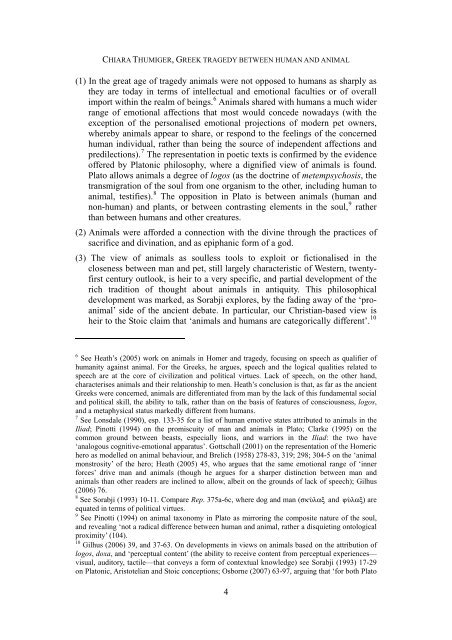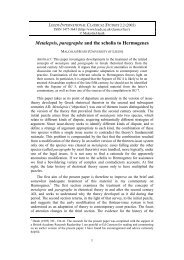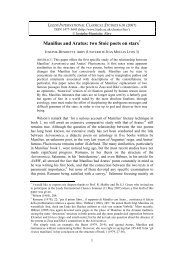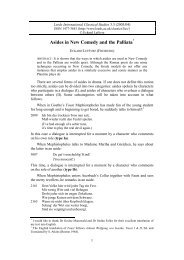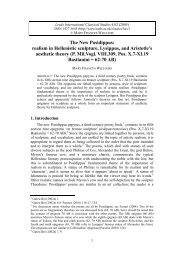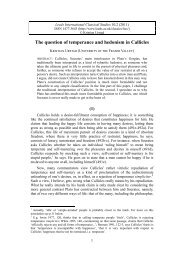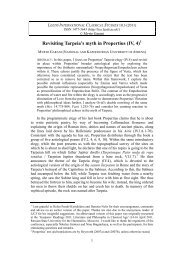Greek Tragedy between Human and Animal - Leeds International ...
Greek Tragedy between Human and Animal - Leeds International ...
Greek Tragedy between Human and Animal - Leeds International ...
You also want an ePaper? Increase the reach of your titles
YUMPU automatically turns print PDFs into web optimized ePapers that Google loves.
CHIARA THUMIGER, GREEK TRAGEDY BETWEEN HUMAN AND ANIMAL<br />
(1) In the great age of tragedy animals were not opposed to humans as sharply as<br />
they are today in terms of intellectual <strong>and</strong> emotional faculties or of overall<br />
import within the realm of beings. 6 <strong>Animal</strong>s shared with humans a much wider<br />
range of emotional affections that most would concede nowadays (with the<br />
exception of the personalised emotional projections of modern pet owners,<br />
whereby animals appear to share, or respond to the feelings of the concerned<br />
human individual, rather than being the source of independent affections <strong>and</strong><br />
predilections). 7 The representation in poetic texts is confirmed by the evidence<br />
offered by Platonic philosophy, where a dignified view of animals is found.<br />
Plato allows animals a degree of logos (as the doctrine of metempsychosis, the<br />
transmigration of the soul from one organism to the other, including human to<br />
animal, testifies). 8 The opposition in Plato is <strong>between</strong> animals (human <strong>and</strong><br />
non-human) <strong>and</strong> plants, or <strong>between</strong> contrasting elements in the soul, 9 rather<br />
than <strong>between</strong> humans <strong>and</strong> other creatures.<br />
(2) <strong>Animal</strong>s were afforded a connection with the divine through the practices of<br />
sacrifice <strong>and</strong> divination, <strong>and</strong> as epiphanic form of a god.<br />
(3) The view of animals as soulless tools to exploit or fictionalised in the<br />
closeness <strong>between</strong> man <strong>and</strong> pet, still largely characteristic of Western, twentyfirst<br />
century outlook, is heir to a very specific, <strong>and</strong> partial development of the<br />
rich tradition of thought about animals in antiquity. This philosophical<br />
development was marked, as Sorabji explores, by the fading away of the ‘proanimal’<br />
side of the ancient debate. In particular, our Christian-based view is<br />
heir to the Stoic claim that ‘animals <strong>and</strong> humans are categorically different’. 10<br />
6<br />
See Heath’s (2005) work on animals in Homer <strong>and</strong> tragedy, focusing on speech as qualifier of<br />
humanity against animal. For the <strong>Greek</strong>s, he argues, speech <strong>and</strong> the logical qualities related to<br />
speech are at the core of civilization <strong>and</strong> political virtues. Lack of speech, on the other h<strong>and</strong>,<br />
characterises animals <strong>and</strong> their relationship to men. Heath’s conclusion is that, as far as the ancient<br />
<strong>Greek</strong>s were concerned, animals are differentiated from man by the lack of this fundamental social<br />
<strong>and</strong> political skill, the ability to talk, rather than on the basis of features of consciousness, logos,<br />
<strong>and</strong> a metaphysical status markedly different from humans.<br />
7<br />
See Lonsdale (1990), esp. 133-35 for a list of human emotive states attributed to animals in the<br />
Iliad; Pinotti (1994) on the promiscuity of man <strong>and</strong> animals in Plato; Clarke (1995) on the<br />
common ground <strong>between</strong> beasts, especially lions, <strong>and</strong> warriors in the Iliad: the two have<br />
‘analogous cognitive-emotional apparatus’. Gottschall (2001) on the representation of the Homeric<br />
hero as modelled on animal behaviour, <strong>and</strong> Brelich (1958) 278-83, 319; 298; 304-5 on the ‘animal<br />
monstrosity’ of the hero; Heath (2005) 45, who argues that the same emotional range of ‘inner<br />
forces’ drive man <strong>and</strong> animals (though he argues for a sharper distinction <strong>between</strong> man <strong>and</strong><br />
animals than other readers are inclined to allow, albeit on the grounds of lack of speech); Gilhus<br />
(2006) 76.<br />
8<br />
See Sorabji (1993) 10-11. Compare Rep. 375a-6c, where dog <strong>and</strong> man (skÚlax <strong>and</strong> fÚlax) are<br />
equated in terms of political virtues.<br />
9<br />
See Pinotti (1994) on animal taxonomy in Plato as mirroring the composite nature of the soul,<br />
<strong>and</strong> revealing ‘not a radical difference <strong>between</strong> human <strong>and</strong> animal, rather a disquieting ontological<br />
proximity’ (104).<br />
10<br />
Gilhus (2006) 39, <strong>and</strong> 37-63. On developments in views on animals based on the attribution of<br />
logos, doxa, <strong>and</strong> ‘perceptual content’ (the ability to receive content from perceptual experiences—<br />
visual, auditory, tactile—that conveys a form of contextual knowledge) see Sorabji (1993) 17-29<br />
on Platonic, Aristotelian <strong>and</strong> Stoic conceptions; Osborne (2007) 63-97, arguing that ‘for both Plato<br />
4


